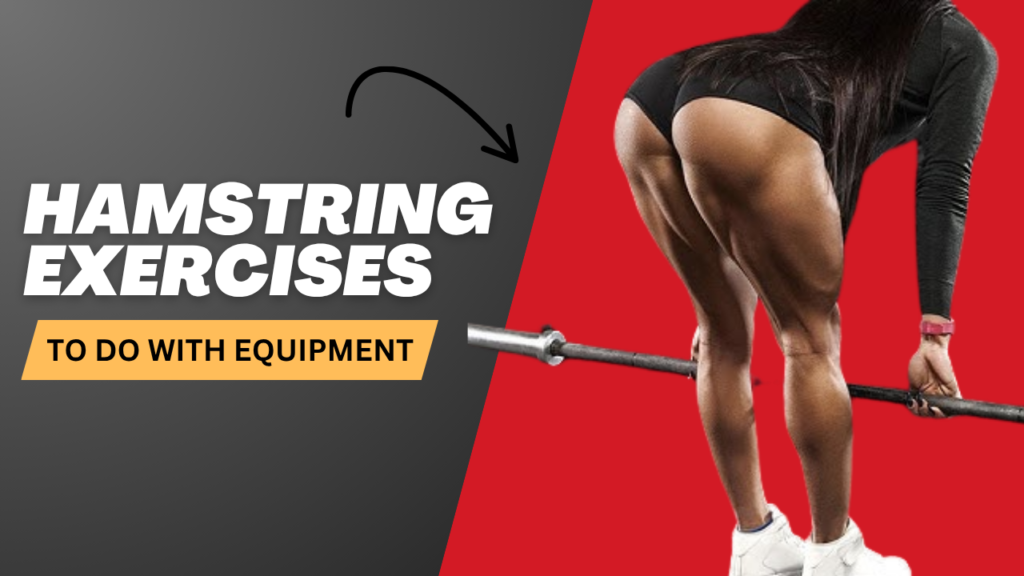Did you know? Your hamstrings aren’t just for running fast or kicking high – they’re crucial for everyday movements like bending, walking, and even standing tall.
Yet, these muscles are often overlooked until pain or injury strikes. Strengthening them can not only prevent injuries but also enhance your athletic performance, posture, and overall strength.
Whether you’re a seasoned gym-goer or just starting out, incorporating equipment-based hamstring exercises into your routine can unlock impressive lower-body power and stability.
Ready to feel the burn? Let’s dive into 14 equipment-based hamstring exercises that will challenge and transform your legs!

Table of Contents
What Can Happen After 30 Days of Doing These Hamstring Exercises:
| Positive Changes | Potential Challenges |
|---|---|
| Improved hamstring strength and endurance | Possible muscle soreness, especially for beginners |
| Enhanced flexibility and range of motion | Risk of injury if form is incorrect or overtraining |
| Better balance and stability for daily activities | Plateaus if not progressively challenging the muscles |
| Toned and firmer appearance in the back of thighs | Risk of fatigue if not balancing training and recovery |
| Increased athletic performance in running & jumping | Possible muscle imbalances if hamstrings are overworked |
| Boosted confidence and motivation for fitness goals | Tightness if flexibility and stretching are ignored |
Do’s and Don’ts for Hamstring Training With Equipment:
| Do’s | Don’ts |
|---|---|
| Warm up before every session with dynamic moves | Skip warm-up or stretch, risking injury |
| Use controlled movements to protect joints | Swing or jerk weights, sacrificing form |
| Start with lighter weights and progress slowly | Lift too heavy too soon, risking strains |
| Focus on full range of motion for each exercise | Perform partial reps, limiting muscle engagement |
| Incorporate both compound and isolation moves | Rely on one type of exercise only |
| Allow sufficient rest between training sessions | Train hamstrings every day, leading to overuse |
| Include mobility and flexibility work | Neglect flexibility, increasing tightness |
| Maintain a neutral spine during lifts | Round the back, risking lower back injury |
| Adjust weight and reps based on form | Compromise form for heavier weights |
| Stay consistent and track progress | Train randomly without a plan |
1. Romanian Deadlifts (RDLs) with Barbell

How to:
- Stand with feet hip-width apart, holding a barbell in front of your thighs.
- With a slight bend in your knees, hinge at the hips and lower the barbell down the front of your legs.
- Keep your back straight and core braced.
- Lower until you feel a stretch in your hamstrings, then return to standing.
Fact: The Romanian Deadlift targets not just hamstrings but also glutes and lower back – a triple win for posterior chain strength!
2. Lying Leg Curl Machine

How to:
- Lie face down on the machine, placing your ankles under the padded lever.
- Grip the handles and flex your knees to curl your legs towards your glutes.
- Slowly lower the weight back down.
Did you know? The Lying Leg Curl isolates the hamstrings more than squats or lunges, making it a fantastic addition to leg day.
3. Seated Leg Curl Machine

How to:
- Sit on the machine with your back pressed against the pad.
- Place your legs over the padded lever and hook your heels underneath.
- Curl your legs back while keeping your thighs stationary.
Tip: Keep the movement slow and controlled to maximize hamstring engagement.
4. Kettlebell Swings

How to:
- Stand with feet slightly wider than hip-width, holding a kettlebell with both hands.
- Hinge at the hips and swing the kettlebell back between your legs.
- Drive your hips forward to swing it to chest height.
Myth Buster: Kettlebell swings aren’t just for cardio – they’re a powerhouse move for your hamstrings, glutes, and lower back!
5. Cable Hamstring Curls

How to:
- Attach an ankle strap to a low cable pulley.
- Stand facing the machine and attach the strap to your ankle.
- Curl your leg back, squeezing the hamstrings at the top, then return.
Fun Fact: Cable curls offer constant tension, which can lead to greater muscle activation compared to free weights.
6. Good Mornings with Barbell

How to:
- Place a barbell on your upper back.
- With knees slightly bent, hinge forward at the hips, keeping your back straight.
- Lower until you feel a stretch in your hamstrings, then return to upright.
Warning: Start light to perfect form and avoid stressing the lower back.
7. Swiss Ball Hamstring Curls

How to:
- Lie on your back with heels on a Swiss ball.
- Lift your hips to form a bridge and curl the ball towards you by bending your knees.
- Slowly return to the start.
Did you know? This exercise challenges stability, engaging your core along with the hamstrings.
8. Glute-Ham Raise (GHR)

How to:
- Secure your feet in the glute-ham developer machine.
- Start in a kneeling position, torso upright.
- Lower your upper body forward while keeping your hips extended, then pull yourself back up using your hamstrings.
Fun Fact: The GHR is considered one of the toughest yet most effective hamstring exercises for both strength and size.
9. Banded Deadlifts

How to:
- Stand on a resistance band with feet hip-width apart.
- Hold the ends of the band in each hand.
- Perform a deadlift motion, hinging at the hips and standing back up against the band’s resistance.
Bonus: Bands add variable resistance, making your hamstrings work harder at the top of the movement.
10. Single-Leg Deadlifts with Dumbbells

How to:
- Hold a dumbbell in each hand, and stand on one leg.
- Hinge at the hips, lowering the dumbbells towards the floor while extending the free leg behind.
- Return to standing.
Challenge: Balance and stability make this move extra effective for unilateral hamstring strength.
11. Nordic Hamstring Curls

How to:
- Kneel on a pad, with feet secured under a heavy object or partner.
- Slowly lower your torso towards the floor, using hamstrings to control the descent.
- Push back up if possible or use your hands for assistance.
Interesting Fact: Nordic curls have been shown to reduce hamstring injury risk in athletes.
12. Smith Machine Good Mornings

How to:
- Stand inside a Smith machine with the bar resting on your upper back.
- Keep knees slightly bent and hinge forward at the hips.
- Lower your torso until you feel a stretch, then return.
Quick Tip: The fixed bar path of the Smith machine can help beginners master form safely.
13. Hip Thrust with Barbell

How to:
- Sit on the floor with your upper back against a bench.
- Roll a barbell over your hips and plant your feet firmly on the floor.
- Drive through your heels to lift your hips until your body forms a straight line from shoulders to knees.
Did you know? While often used for glutes, hip thrusts also activate the hamstrings significantly, especially at lockout.
14. Reverse Hyperextensions (Machine)

How to:
- Lie face down on a reverse hypermachine, with legs hanging off the back.
- Engage your glutes and hamstrings to lift your legs upward until parallel to the floor.
- Slowly lower them back down.
Bonus Fact: This exercise decompresses the lower back while strengthening the hamstrings – a two-in-one benefit.
Final Thoughts
Hamstrings are the unsung heroes of your lower body, playing a pivotal role in stability, power, and mobility. Incorporating these 14 equipment-based hamstring exercises into your training plan can help unlock stronger, more resilient legs.
Whether you’re lifting barbells, swinging kettlebells, or curling on machines, remember: a strong backline makes for a strong athlete. Start incorporating these moves today, and you’ll feel the difference with every step!
Frequently Asked Questions (FAQs)
How often should I train my hamstrings?
For balanced strength and muscle growth, training hamstrings 1-3 times per week is generally recommended. Allow at least 48 hours of recovery between sessions to prevent overtraining. Frequency can be adjusted based on your goals, experience, and recovery ability.
Can I train hamstrings on the same day as other leg muscles?
Yes! Many athletes combine hamstring exercises with quadriceps and glute training in the same session (often called “leg day”). However, because hamstrings assist in movements like squats and lunges, some lifters prefer to dedicate a separate session for focused hamstring work.
Can beginners do these exercises?
Absolutely! Beginners should start with lighter weights and controlled form. Machines (like seated and lying leg curls) are great for safely isolating hamstrings. As experience and strength increase, progress to free weight exercises like RDLs and hip thrusts.
Are hamstring exercises necessary if I already squat and lunge?
Squats and lunges involve hamstrings but emphasize quads and glutes. Direct hamstring training ensures balanced development and reduces the risk of hamstring strains or injuries. Plus, targeted exercises enhance athletic performance, sprinting speed, and stability.
Which exercise is best for building hamstring size?
Compound movements like Romanian Deadlifts and Glute-Ham Raises are particularly effective for hypertrophy (muscle growth). Combine them with isolation exercises like leg curls and cable curls for comprehensive development.
Can I do these exercises at home if I have equipment?
Absolutely! Many of these exercises (like RDLs, kettlebell swings, banded deadlifts, and Swiss ball curls) can be performed at home if you have dumbbells, resistance bands, or a stability ball. A creative setup can turn your home into an effective hamstring training space.
How long will it take to see results?
Visible changes in muscle size and strength can be noticed in 4-8 weeks with consistent training, proper nutrition, and recovery. Keep in mind that genetics, training intensity, and diet play significant roles.
Should I train hamstrings differently if I’m an athlete?
Yes. Athletes benefit from a mix of strength, stability, and explosive exercises. Incorporating plyometric drills, Nordic curls, and eccentric-focused moves can enhance athletic performance and resilience against injury.










